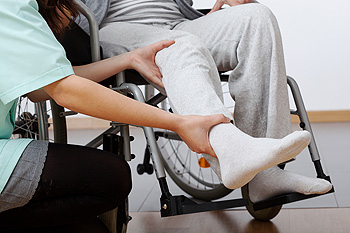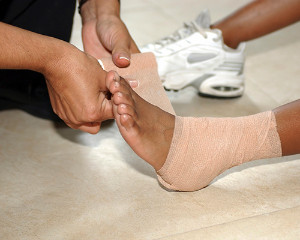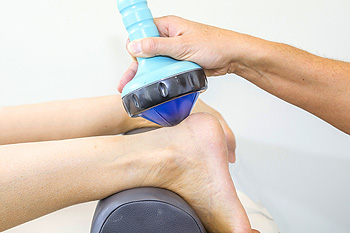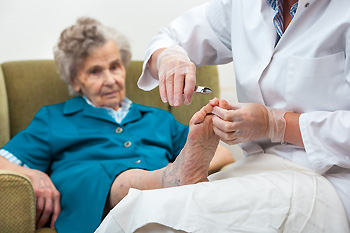January 2019
It's Time for Beautiful Feet.
Rheumatoid Arthritis in the Ankles
 Rheumatoid arthritis usually affects small joints first, but it can move to larger joints, such as ankles. If this condition spreads to the ankles, then it can hinder one’s ability to walk, and cause extreme discomfort. Symptoms of rheumatoid arthritis usually come in flares that can last anywhere from a couple days to a couple weeks. These symptoms include inflammation and stiffness in the joints of the ankle. If this goes untreated, then this condition has the potential to permanently change the structure of the ankle joints. Rheumatoid arthritis also breaks down cartilage in the ankle that protects the bones from rubbing together, so this may create friction that will cause further weakness and instability. Oftentimes, people with rheumatoid arthritis in the ankles also experience symptoms in their feet. If you feel that you may have rheumatoid arthritis in either your feet or ankles, then it is strongly recommended that you consult with a podiatrist to receive treatment.
Rheumatoid arthritis usually affects small joints first, but it can move to larger joints, such as ankles. If this condition spreads to the ankles, then it can hinder one’s ability to walk, and cause extreme discomfort. Symptoms of rheumatoid arthritis usually come in flares that can last anywhere from a couple days to a couple weeks. These symptoms include inflammation and stiffness in the joints of the ankle. If this goes untreated, then this condition has the potential to permanently change the structure of the ankle joints. Rheumatoid arthritis also breaks down cartilage in the ankle that protects the bones from rubbing together, so this may create friction that will cause further weakness and instability. Oftentimes, people with rheumatoid arthritis in the ankles also experience symptoms in their feet. If you feel that you may have rheumatoid arthritis in either your feet or ankles, then it is strongly recommended that you consult with a podiatrist to receive treatment.
Ankle pain can be caused by a number of problems and may be potentially serious. If you have ankle pain, consult with Dr. Craig Campbell from Salt Lake City, Utah. Our doctor will assess your condition and provide you with quality foot and ankle treatment.
Ankle pain is any condition that causes pain in the ankle. Due to the fact that the ankle consists of tendons, muscles, bones, and ligaments, ankle pain can come from a number of different conditions.
Causes
The most common causes of ankle pain include:
- Types of arthritis (rheumatoid, osteoarthritis, and gout)
- Ankle sprains
- Broken ankles
- Achilles tendinitis
- Achilles tendon rupture
- Stress fractures
- Bursitis
- Tarsal tunnel syndrome
- Plantar fasciitis
Symptoms
Symptoms of ankle injury vary based upon the condition. Pain may include general pain and discomfort, swelling, aching, redness, bruising, burning or stabbing sensations, and/or loss of sensation.
Diagnosis
Due to the wide variety of potential causes of ankle pain, podiatrists will utilize a number of different methods to properly diagnose ankle pain. This can include asking for personal and family medical histories and of any recent injuries. Further diagnosis may include sensation tests, a physical examination, and potentially x-rays or other imaging tests.
Treatment
Just as the range of causes varies widely, so do treatments. Some more common treatments are rest, ice packs, keeping pressure off the foot, orthotics and braces, medication for inflammation and pain, and surgery.
If you have any questions, please feel free to contact our office located in Salt Lake City, UT. We offer the newest diagnostic and treatment technologies for all your foot care needs.
Read more about Ankle Pain
Treating Fungal Nails with Laser Treatment
 Fungal nail infection (onychomycosis) is one of the most common nail disorders among adults. It is a mycotic infection that occurs underneath the nail plate. The nail can become deformed, lifted, brittle, and discolored. These symptoms may lead to acute pain in the toenail area. There are various types of fungal nail infections and various types of treatments. One form of treatment is laser therapy, which also consists of varying methods. Photodynamic therapy uses light irradiation and a photosensitizing drug to find specific cells and destroy them. Other laser therapies that involve neodymium yttrium-aluminum-garnet or low-level lasers aim to selectively hinder fungal growth. Laser therapies are selective to the localized infection, which decreases the chance of systemic side effects. If you are interested in laser treatment for a fungal infection, consult with a podiatrist for further guidance.
Fungal nail infection (onychomycosis) is one of the most common nail disorders among adults. It is a mycotic infection that occurs underneath the nail plate. The nail can become deformed, lifted, brittle, and discolored. These symptoms may lead to acute pain in the toenail area. There are various types of fungal nail infections and various types of treatments. One form of treatment is laser therapy, which also consists of varying methods. Photodynamic therapy uses light irradiation and a photosensitizing drug to find specific cells and destroy them. Other laser therapies that involve neodymium yttrium-aluminum-garnet or low-level lasers aim to selectively hinder fungal growth. Laser therapies are selective to the localized infection, which decreases the chance of systemic side effects. If you are interested in laser treatment for a fungal infection, consult with a podiatrist for further guidance.
Laser treatment can be an effective way to get rid of toenail fungus. If you have any questions about laser treatment, consult with Dr. Craig Campbell from Salt Lake City, Utah. Our doctor will assess your condition and provide you with quality treatment for fungal nails.
What Are Toenail Fungal Infections?
Onychomycosis, or fungal infection of the nail, is a relatively common and non-serious condition. Around 10 percent of U.S. citizens are afflicted with fungal nails. Common forms of fungus that infect the nail include dermatophytes, yeasts, and molds.
Symptoms of Toenail Fungal Infections Include:
- Nail thickening
- Brittleness of the nail
- Discoloration of the nail
Diagnosis for Fungal Nails
Fungal infections are diagnosed by fungal culture and microscopy. This will rule out any other conditions such as nail trauma, psoriasis, lichen planus, and onychogryphosis.
What Is Laser Treatment?
Laser treatment is a non-invasive, safe, quick, and painless procedure that uses the heat from a laser to kill fungus in the nail. Each infected nail is targeted with a laser for several minutes. The treatment is usually utilized several different times over a select period. During this time, a podiatrist will keep an eye on the infection.
If you have any questions, please feel free to contact our office located in Salt Lake City, UT. We offer the newest diagnostic and treatment technologies for all your foot care needs.
Read more about Laser Treatment for Fungal NailsHeel Pain Can be Treated!
Ankle Sprains May Take Time to Heal
 Research has shown that several athletes endure injuries to the ankles, and many of these are ankle sprains. It may also be common among the general population, and many people will experience this type of injury at some point in their lives. It generally occurs when the ankle rolls inward, and severe pain and discomfort may often accompany ankle sprains. It may happen as a result of suddenly stepping off a curb or falling from an extended height. This type of injury requires patience and time to heal properly, and walking on it must be executed gently. Once the ankle sprain has occurred, it’s important to rest the foot, which allows pressure to be taken off the ankle. Applying ice to the affected area may be helpful in alleviating a portion of the swelling that may be present, in addition to wrapping the foot in a bandage, which may be useful in applying pressure. If you have sprained your ankle, it is suggested to speak with a podiatrist as quickly as possible, so the correct treatment can begin.
Research has shown that several athletes endure injuries to the ankles, and many of these are ankle sprains. It may also be common among the general population, and many people will experience this type of injury at some point in their lives. It generally occurs when the ankle rolls inward, and severe pain and discomfort may often accompany ankle sprains. It may happen as a result of suddenly stepping off a curb or falling from an extended height. This type of injury requires patience and time to heal properly, and walking on it must be executed gently. Once the ankle sprain has occurred, it’s important to rest the foot, which allows pressure to be taken off the ankle. Applying ice to the affected area may be helpful in alleviating a portion of the swelling that may be present, in addition to wrapping the foot in a bandage, which may be useful in applying pressure. If you have sprained your ankle, it is suggested to speak with a podiatrist as quickly as possible, so the correct treatment can begin.
Ankle sprains are common but need immediate attention. If you need your feet checked, contact Dr. Craig Campbell from Salt Lake City, Utah. Our doctor can provide the care you need to keep you pain-free and on your feet.
How Does an Ankle Sprain Occur?
Ankle sprains take place when the ligaments in your ankle are torn or stretched beyond their limits. There are multiple ways that the ankle can become injured, including twisting or rolling over onto your ankle, putting undue stress on it, or causing trauma to the ankle itself.
What Are the Symptoms?
- Mild to moderate bruising
- Limited mobility
- Swelling
- Discoloration of the skin (depending on severity)
Preventing a Sprain
- Wearing appropriate shoes for the occasion
- Stretching before exercises and sports
- Knowing your limits
Treatment of a Sprain
Treatment of a sprain depends on the severity. Many times, people are told to rest and remain off their feet completely, while others are given an air cast. If the sprain is very severe, surgery may be required.
If you have suffered an ankle sprain previously, you may want to consider additional support such as a brace and regular exercises to strengthen the ankle.
If you have any questions please feel free to contact our office located in Salt Lake City, UT. We offer the newest diagnostic and treatment technologies for all your foot and ankle needs.
Read more about Ankle SprainsThe Benefits of Shockwave Therapy
 The benefits of using a method that is referred to as shockwave therapy may be experienced as accelerated pain relief and ease in mobility. It is defined as an acoustic energy wave that may provide relief to patients who have chronic foot conditions. It is administered through an applicator that consists of compressed air and is injected into the affected area. It may be effective in improving blood flow to the damaged tissue, in addition to stimulating the formation of new blood vessels. It has been known to reverse chronic inflammation, and this may bring moderate desired relief. If you would like additional information about shockwave therapy, please consult with a podiatrist to see if this type of treatment is correct for you.
The benefits of using a method that is referred to as shockwave therapy may be experienced as accelerated pain relief and ease in mobility. It is defined as an acoustic energy wave that may provide relief to patients who have chronic foot conditions. It is administered through an applicator that consists of compressed air and is injected into the affected area. It may be effective in improving blood flow to the damaged tissue, in addition to stimulating the formation of new blood vessels. It has been known to reverse chronic inflammation, and this may bring moderate desired relief. If you would like additional information about shockwave therapy, please consult with a podiatrist to see if this type of treatment is correct for you.
Shockwave therapy is a treatment commonly used to treat various injuries and conditions, particularly plantar fasciitis in the feet. To learn more, consult with Dr. Craig Campbell from Salt Lake City, Utah. Our doctor can provide the care you need to keep you pain-free and on your feet.
Shockwave Therapy
Shockwave therapy is a new treatment option designed to treat bone conditions such as tennis elbow, shoulder pain, and others. Shockwave therapy uses high intensity sound waves that are directed to the affected tissues of the body with pinpoint accuracy. The effects are very beneficial, leading to a production of collagen fibers, eliminating inflammation.
Who Benefits from Shockwave?
Shockwave is recommended for patients suffering from heel pain and associated problems. Heel pain is a common condition which can be caused by obesity, overexertion, and spending a substantial amount of time on hard floors with your feet exposed and unsupported.
Fast and Easy
The therapy is actually a simple process that can leave patients feeling better the very next day. Shockwave therapy is not as dramatic as it sounds. It enables more blood flow to effected areas, addressing the source of the problem and allowing treatment to last for a long time.
Treatment & Recovery Time
Shockwave treatment will enable your feet to recover quickly. This is especially important since surgery is not required. It is cost effective and does not require the use of anesthesia. This treatment is a better option to surgery, since it is proven safe.
If you have any questions, please feel free to contact our office located in Salt Lake City, UT. We offer the newest diagnostic and treatment technologies for all your foot and ankle needs.
Read more about Shockwave TherapyReminder - When was the last time...
How to Manage Elderly Feet
 Research has shown that it may be common for elderly people to develop uncomfortable foot conditions as the aging process occurs. It’s important to take proper care of your feet at any age, and this is especially true of the elder population. There are several methods to keep the feet healthy, and these may include incorporating gentle foot exercises and walking for short periods of time into your daily activities. This may aid in keeping the muscles in the feet strong, which can help in maintaining the balance that is necessary to prevent falling. There are several daily routines that can be implemented to keep the feet healthy, and these may include observing your feet daily, which may help in noticing any cuts or bruises, washing your feet every day, in addition to wearing shoes and socks that fit correctly. If you would like additional information about the importance of taking care of elderly feet, please consult with a podiatrist for proper guidance.
Research has shown that it may be common for elderly people to develop uncomfortable foot conditions as the aging process occurs. It’s important to take proper care of your feet at any age, and this is especially true of the elder population. There are several methods to keep the feet healthy, and these may include incorporating gentle foot exercises and walking for short periods of time into your daily activities. This may aid in keeping the muscles in the feet strong, which can help in maintaining the balance that is necessary to prevent falling. There are several daily routines that can be implemented to keep the feet healthy, and these may include observing your feet daily, which may help in noticing any cuts or bruises, washing your feet every day, in addition to wearing shoes and socks that fit correctly. If you would like additional information about the importance of taking care of elderly feet, please consult with a podiatrist for proper guidance.
Proper foot care is something many older adults forget to consider. If you have any concerns about your feet and ankles, contact Dr. Craig Campbell from Salt Lake City, Utah. Our doctor can provide the care you need to keep you pain-free and on your feet.
The Elderly and Their Feet
As we age we start to notice many changes in our body, but the elder population may not notice them right away. Medical conditions may prevent the elderly to take notice of their foot health right away. Poor vision is a lead contributor to not taking action for the elderly.
Common Conditions
- Neuropathy – can reduce feeling in the feet and can hide many life-threatening medical conditions.
- Reduced flexibility – prevents the ability of proper toenail trimming, and foot cleaning. If left untreated, it may lead to further medical issues.
- Foot sores – amongst the older population can be serious before they are discovered. Some of the problematic conditions they may face are:
- Gouging toenails affecting nearby toe
- Shoes that don’t fit properly
- Pressure sores
- Loss of circulation in legs & feet
- Edema & swelling of feet and ankles
Susceptible Infections
Diabetes and poor circulation can cause general loss of sensitivity over the years, turning a simple cut into a serious issue.
If you have any questions please feel free to contact our office located in Salt Lake City, UT. We offer the newest diagnostic and treatment technologies for all your foot and ankle needs.
Read more about Taking Care of Elderly Feet








